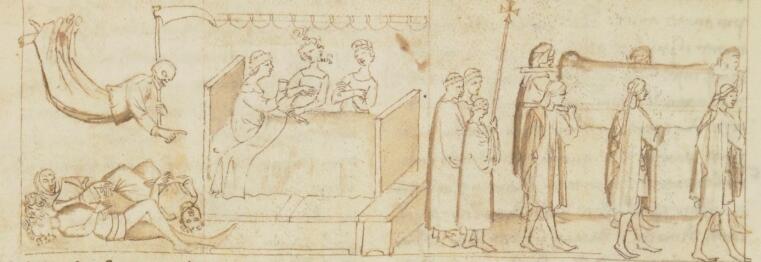Boccaccio’s Decameron, or the art of storytelling as a remedy against the plague
By literary scholar Pia Claudia Doering (Romance studies)

Boccaccio’s collection of novellas, which dates from around 1350, the time of the Great Plague, begins with one of the most famous depictions of the plague in European literature. The narrator vividly describes how the plague brought social life in the city of Florence to a standstill. Although the number of doctors increases rapidly, they by no means all agree in their expertise, some of them do not even have a medical training, and what they all have in common is that they cannot find a cure for the disease because ultimately they do not understand how it works. But it is not only medicine that reaches its limits; politics, law and religion also fail in the face of the plague. Laws lose their authority because nobody monitors whether they are being observed or not. Wakes and Christian burials are no longer held due to the large death toll and fear of infection. The priests no longer bother to hold a solemn ceremony, but leave it to the new professional group of the becchini to be paid to bury the corpses in mass graves. The consequences of the plague show themselves most drastically, though, within the smallest social structure of all, the family: the fear of illness and death causes people to abandon their sick relatives, and even parents to turn away from their children.
According to the Decameron’s frame narrative, it is in this dire situation that a group of ten young people decide to leave the city and flee to the countryside. In the beautiful and serene surroundings of a country villa, they each tell each other ten stories over a period of ten days, before then making the decision to return to Florence. This decision, which is not explained in detail, is surprising since the storytellers had initially justified their flight to the countryside with the argument derived from natural law that they must preserve their own lives. And now they intended to return to Florence, although the plague was still ravaging there. How can this be? What has changed on account of the ‘time out’ outside the walls of Florence?
The difference between the ‘before’ and the ‘after’ is precisely the storytelling. A central concern of both Boccaccio’s Latin and vernacular works is to emphasize the importance of literature, which in late medieval society was competing for prestige with theology, philosophy and jurisprudence. In telling their stories, the ten young people, unlike the doctors and other scholars, find an antidote to the plague, and not only in the sense of distraction and social pastimes. Rather, the stories deal with social problems that already existed before the outbreak of the plague, but which have become more acute as a result of it, including the hypocrisy of the clergy and the question of the limits of expert knowledge, and indeed of human knowledge in general. Narrating the novellas opens up a way of speaking that does not aim to establish simple causalities, but gives room to the plurality of interpretations and opinions. In a playful and stimulating way, it creates knowledge outside closed groups of scholars. Thus, at the end of the Decameron, we are still in the midst of a crisis, but the stories prepare us to deal with this crisis better.

